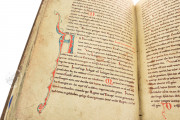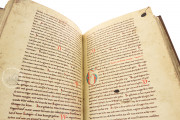The Karlsruhe Nibelungenlied is an early copy of Nibelungenlied ("Song of the Nibelungs"), a tragic-heroic epic poem in Middle High German based on earlier saga traditions. Its thirty-nine chapters relate the exploits of the dragon slayer Siegfried and, after his murder by Hagen, Siegfried's wife Kriemhild. The manuscript was produced in the second quarter of the thirteenth century in Lower Bavaria. The poem is immediately followed by the Klage ("Complaint"), a short interpretation of the Nibelungenlied.
The Karlsruhe manuscript, sometimes referred to as the Donaueschingen manuscript after its previous location, is known to scholars as Manuscript C of the Nibelungenlied. It is the oldest of the three early manuscripts of the epic that have informed the modern reception of the text, the others being in Munich and St. Gall.
Puzzle Initials
The manuscript has two enlarged two-color initials with foliate designs, one at the opening of the Lied and the other marking the beginning of Klage (fols. 1r and 89r). Each aventure (French for "adventure") or chapter (except chapter 34) opens with a pen-flourished puzzle initial, its red and blue shapes interlocking like the pieces of a jigsaw puzzle.
Rhyming Couplets
The poem comprises more than 2,300 four-line stanzas, each composed of two rhyming couplets, with the last line usually longer than the others. It is a self-conscious form meant to evoke oral poetry and suggest a bygone heroic era.
The scribe, writing Gothic Textualis script, presents the poem continuously in long lines spanning the width of the page, without line breaks at the ends of verses. The verse form is articulated principally by touches of red on the opening majuscule of each stanza, a scheme sometimes obscured by the practice of using the same device to highlight proper names.
Two Compelling Stories
The Nibelungenlied is the best-known heroic epic of the German High Middle Ages. It is nearly equally divided into the story of the deeds and murder of Siegfried and the saga of Kriemhild, who sought to avenge his death and is also murdered. The overarching theme is that all happiness eventually leads to grief, although the events are lively and involve love, heroism, deceit, and magic.
UNESCO Memory of the World
The Karlsruhe manuscript belonged in the fifteenth century to one Heinrich Durricher, who claimed ownership in an inscription. By the mid-eighteenth century, it was in the library of the Counts of Hohenems in Vorarlberg. In 1807, Maria Walburga (1762-1828), the last Countess of Hohenems, gave it to the jurist Michael Schuster (1767-1834). Joseph Laßberg (1770-1855) then acquired it in 1815, and it entered the library of the Princes of Fürstenberg in Donaueschingen upon his death.
The manuscript was purchased by the Landesbank Baden-Württemberg and the Federal Republic of Germany in 2001 and has since been preserved in Karlsruhe. In 2009, the three early Nibelungenlied manuscripts—Karlsruhe, Munich, and St. Gall—were named to the UNESCO Memory of the World Register.
We have 1 facsimile edition of the manuscript "Karlsruhe Nibelungenlied": Nibelungenlied und Klage: Handschrift C der F.F. Hofbibliothek Donaueschingen facsimile edition, published by Mueller & Schindler, 1968
Request Info / Price

















